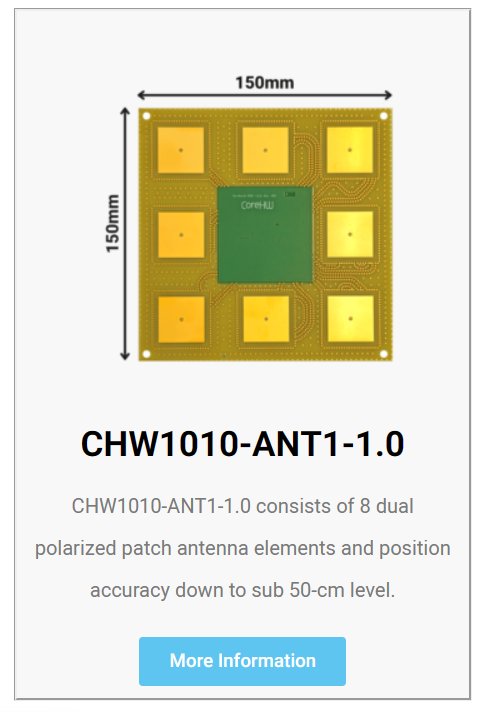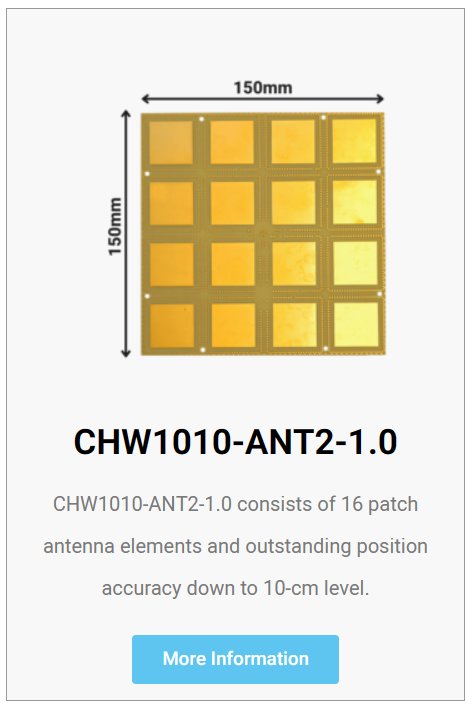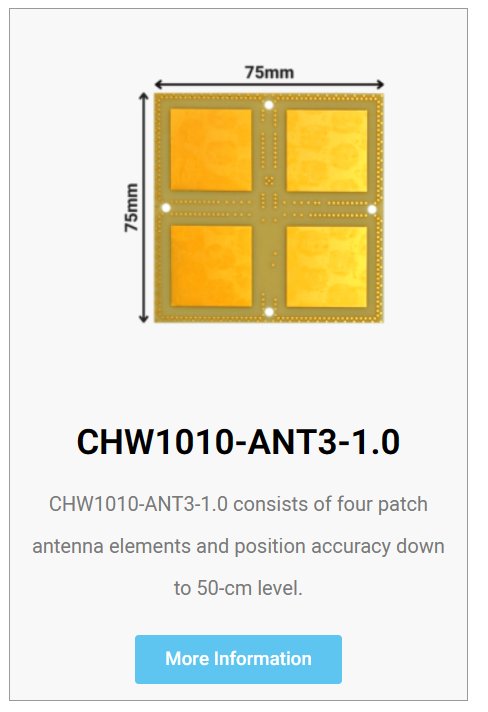Accurate Positioning Systems and Proximity Solutions with CoreHW Bluetooth® AoA and AoD Antenna Modules
Bluetooth® 5.1 Direction Finding Using Angle of Arrival (AoA) & Angle of Departure (AOD)
February 17, 2023 -- The Bluetooth-based indoor positioning solutions are becoming more popular technology due to their cost efficiency, low positioning errors, few necessary equipment, and a broad range of applications. In the following, we will introduce CoreHW’s Bluetooth® antenna modules, which are the main components of Bluetooth® direction finding and indoor positioning technology.
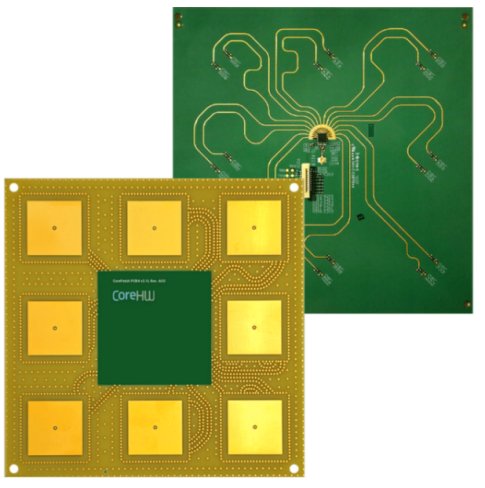
CHW1010-ANT1-1.0 Antenna Array
CoreHW Bluetooth® indoor positioning supports angle of arrival (AoA) to determine the tag’s location in real-time with cm-level accuracy. This technology benefits from the vast ecosystem of Bluetooth®, which is growing due to its low cost, high accuracy, and easy installation and maintenance. In the angle of departure (AoD), beacons transmit direction finding signals to a receiving device such as a smartphone or a robot. The device calculates the signal direction and its own position based on several angle calculations with cm-level accuracy.
The number of antennas determines the accuracy of a direction finding system. However, a higher number of antennas require a larger PCB size and more calculations. To meet your specific needs, CoreHW offers antenna array boards in multiple form factors. These boards are in 2400-2483 MHz frequency range and up to 16 single-ended antenna ports.
Advantages of Utilizing CoreHW Bluetooth® Direction Finding Antenna Modules
Implementing indoor location solutions involves picking up an antenna array, sophisticated angle calculation software and positioning software. These hardware and software requirements for Bluetooth® direction-finding depends on the level of accuracy expected from the positioning system. CoreHW antenna modules and direction finding algorithm provide a positional accuracy of between 10 and 50 cm, depending on the implementation environment.
CoreHW antenna boards are carefully designed for very low phase mismatch between antenna elements. These antenna array boards contain the CHW1010 SP16T Bluetooth® AoA and AoD antenna switch for antenna selection, along connectors for RF and digital control signals for easy interfacing BLE SoC control boards. It allows designs with only a single switch component, while three to five components are usually required. Our industry-leading antenna switch is designed to transfer the real-time location data with a powerful indoor positioning and outstanding power efficiency.
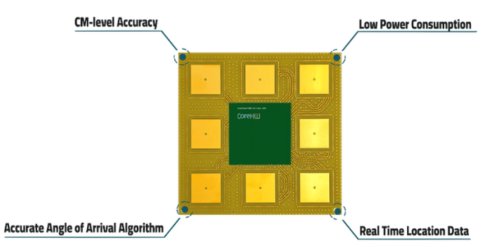
Broad Applications
Here are some of many antenna modules applications and purposes the system can serve. This is a short list to understand how this technology can transform your business.
Warehouse: Our solution enhances reliability and safety in warehouses by providing real-time package location, inventory quantity monitoring, and forklifts high-precision positioning.
Airport and Hospitality: Airports and hotels can track heavy equipment, passenger baggage, and visitors to improve daily operations, increase safety, and increase customer satisfaction.
Access Control and Security: Our indoor positioning solution enables you to monitor the movement and entrance of employees and visitors in any premises.
Retail: Shopping centers benefit from this technology by tracking the shopping carts and providing consumer guidance and wayfinding in large stores.
Health Centers: By using this technology, staffs, patients, and equipment such as beds and wheelchairs can be easily located.
AoA Locator and AoD Beacon Development Based on CoreHW Antenna Modules
When developing locators and beacons based on CoreHW antenna boards, the following factors need to be considered:
- Accuracy requirement
- Severity of multi-path conditions
- Line of sight / non-line of sight
- Elevation angle between locator and tag
- Density of locator installation grid
The best performance is normally achieved by installing locators and beacons on the ceiling and pointing antenna arrays towards the floor. For AoA, each tag would need to be seen by three to four locators, in a way that the elevation angle from each 3 (or 4) locators is over 15–20 degrees. As a rule of thumb, each locator can track within a cylinder beam of about 140–150 degrees. For AoD, each device (like a smartphone) needs to see at least three to four beacons.
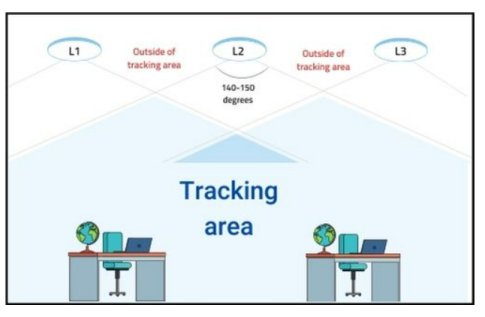
CoreHW End-Products: AoA Evaluation Kits
CoreHW antenna boards are the main components of our evaluation kits including EVKN1-1.0, EVKN2-1.0, EVKN3-1.0, and EVKN4-1.0. Our evaluation kits enable developers a quick way to evaluate and test the antenna boards and direction finding algorithms.
These kits include AoA locators, tags, USB interface (Ethernet) to connect locators to a Windows PC, and 3D software for angle and position estimation. Using our kits enable the solution developers to easily implement positioning solutions. This will be a comprehensive solution for end-product users like warehouses, health centers and retails.
Watch video
|
||||||
CoreHW Hot IP
Related News
- Silicon Labs Selects CoreHW Advanced Bluetooth AoA Switch for Dual Polarized Antenna Array Pro Kit
- CEVA Introduces Channel Sounding over Bluetooth® to Enable High-Accuracy Secure Positioning for Automotive, Industrial and the IoT Ecosystem
- Bluetooth® V6.0 Channel Sounding RF Transceiver IP Core in 22nm & 40nm for ultra-low power distance aware Bluetooth connected devices
- CoreHW, in Partnership with Unikie, Introduces a Novel RTLS Technology that Significantly Enhances Power Efficiency and Positioning Accuracy
- CEVA Bluetooth® 5.4 IP Achieves SIG Qualification, Includes New Features to Address Rapidly Growing Electronic Shelf Label (ESL) Market
Breaking News
- JEDEC® and Industry Leaders Collaborate to Release JESD270-4 HBM4 Standard: Advancing Bandwidth, Efficiency, and Capacity for AI and HPC
- BrainChip Gives the Edge to Search and Rescue Operations
- ASML targeted in latest round of US tariffs
- Andes Technology Celebrates 20 Years with New Logo and Headquarters Expansion
- Creonic Unveils Bold Rebrand to Drive Innovation in Communication Technologies
Most Popular
- Cadence to Acquire Arm Artisan Foundation IP Business
- AMD Achieves First TSMC N2 Product Silicon Milestone
- Why Do Hyperscalers Design Their Own CPUs?
- Siemens to accelerate customer time to market with advanced silicon IP through new Alphawave Semi partnership
- New TSN-MACsec IP core for secure data transmission in 5G/6G communication networks
|
|
E-mail This Article |
|
Printer-Friendly Page |









